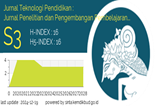Development of Three˗Tier Diagnostic Test Instrument to Measure Misconceptions of Class XI Students on Reaction Rate Materials
Abstract
This study aims to measure and detect student misconceptions that occur in the concept of reaction rate based on the diagnosis results of Grade XI Negeri 2 Kabanjahe students and to show subconceptions that experienced both high and low misconceptions. The study was conducted in March–April 2022. The type of research used is Research and Development with ADDIE development. Methods used are tests, anchors, interviews and documentation. The diagnostic test developed is a threetitier multiple choice diagnostic test consisting of an answer choice, reason and confidence level. Validation result by validator indicates the developed instrument is valid. The validity of the developed test is 20 valid problems and 10 invalid problems. Reliability test results show a reliability figure of 0.85. The highest percentage of misconceptions in collision theory is 51.5% and the lowest percentage of misconceptions in reaction order and reaction rate equations is 26.72%. The percentage of students who understand the concept of reaction rate is 35%. The percentage of categories did not understand the concept of reaction rate by 27% and the percentage of misconceptions of reaction rate by 38%.
Keywords
Full Text:
PDFReferences
Arikunto, S. (2010). Dasar˗Dasar Evaluasi Pendidikan. Jakarta: Bumi Aksara.
__________. (2013). Prosedur Penelitian: Suatu Pendekatan Praktik. Jakarta: Rikena Cipta.
Ardiansah, Masykuri, M., & Rahardjo, S. B. (2018). Senior High School Students’ Need Analysis of Three-Tier Multiple Choice (3TMC) Diagnostic Test about Acid-Base and Solubility Equilibrium. Journal of Physics: Conference Series, 1022, 1–8. https://doi.org/10.1088/1742-6596/1022/1/012033
Asmalinda, Ruslan, & Sulastry Taty. (2019). Pengembangan Instrumen Tes Diagnostik Tiga Tingkat dan Alternatif Remedial pada Pembelajaran Kimia Kelas X SMA (Studi pada Materi Struktur Atom). Chemistry Education Review, 3(1), 99–108.
Bagiyono. (2017). Analisis Tingkat Kesukaran dan Daya Pembeda Butir Soal Ujian Pelatihan Radiografi Tingkat 1 (The Analysis of Difficulty Level and Discrimination Power of Test Items of Radiography Level 1 Examination). Widyanuklida, 16(1), 1–12. http://repo-nkm.batan.go.id/140/1/05_analisis_tingkat_kesukaran.pdf
Dwinata, R. A., Efendi, R., & Yudha, S. P. (2016). Rancang Bangun Aplikasi Tabel Periodik Unsur dan Perumusan Senyawa Kimia dari Unsur Kimia Dasar Berbasis Android. Jurnal Rekursif, 4(2), 176–183.
Fadhilah, Jusniar, & Anwar, M. (2020). Analisis Miskonsepsi Siswa Kelas XI IPA 1 SMA Negeri 1 Ma’rang pada Materi Pokok Laju Reaksi. Jurnal Ilmiah Pendidikan Kimia, 1(1), 41–50. https://ojs.unm.ac.id/ChemEdu/article/view/17526/0
Fahmi, F., & Irhasyuarna, Y. (2017). Misconceptions of Reaction Rates on High School Level in Banjarmasin. IOSR Journal of Research & Method in Education (IOSR-JRME), 7(1), 54–61. https://doi.org/10.9790/7388-0701045461
Jannah, M., Ningsih, P., & Ratman, R. (2017). Analisis Miskonsepsi Siswa Kelas XI SMA Negeri 1 Banawa Tengah pada Pembelajaran Larutan Penyangga dengan CRI (Certainty of Response Index). Jurnal Akademika Kimia, 5(2), 85–90. https://doi.org/10.22487/j24775185.2016.v5.i2.8019
Maulini, S., Kurniawan, Y., & Muliyani, R. (2016). The Three Tier-Test untuk Mengungkap Kuantitas Siswa Yang Miskonsepsi pada Konsep Gaya Pegas. JIPF (Jurnal Ilmu Pendidikan Fisika), 1(2), 42–44. https://doi.org/10.26737/jipf.v2i2.222
Nurhayati, Alsagaf, S. L. H., & Wahyudi. (2019). Pengembangan Tes Diagnostik Three-Tier Multiple Choice untuk Mengukur Konsepsi Fisika Siswa SMA. Jurnal Pendidikan, 4(2), 47–54.
Nurpratami, H., Farida, I., & Helsy, I. (2015). Pengembangan Bahan Ajar pada Materi Laju Reaksi Berorientasi Multipel Representasi Kimia. Simposium Nasional Inovasi Pembelajaran Sains, 353–356.
Peşman, H., & Eryilmaz, A. (2010). Development of a Three-Tier Test to Assess Misconceptions About Simple Electric Circuits. Journal of Educational Research, 103(3), 208–222. https://doi.org/10.1080/00220670903383002
Prastyaninda, F. A., Pujayanto, & Budiharti, R. (2014). Penerapan Model Evaluasi Diary Book pada Pembelajaran Kooperatif Tipe Numbered Heads Together (NHT) untuk Meningkatkan Kemampuan Berpikir Kreatif dan Kognitif Fisika Siswa Kelas X SMA Negeri Gondangrejo. Jurnal Pendidikan Fisika Universitas Sebelas Maret, 2(2), 20–24.
Saat, R. M., Fadzil, H. M., Aziz, N. A., Haron, K. A., Rashid, K. A., & Shamsuar, N. R. (2016). Development of An Online Three-Tier Diagnostic Test to Assess Pre-University Students’ Understanding of Cellular Respiration. Journal of Baltic Science Education, 15(4), 532–546.
Shalihah, A., Mulhayayiah, D., & Alatas, F. (2016). Identifikasi Miskonsepsi Menggunakan Tes Diagnostik Three-Tier pada Hukum Newton dan Penerapannya. Journal of Teaching and Learning Physics, 1(1), 24–33.
Silitonga, P. M. (2014). Statistik: Teori dan Aplikasi dalam Penelitian. Medan: FMIPA Unimed
Siswaningsih, W., Anisa, N., Komalasari, N. E., & R, I. (2014). Pengembangan Tes Diagnostik Two-Tier untuk Mengidentifikasi Miskonsepsi pada Materi Kimia Siswa SMA. Jurnal Pengajaran MIPA, 19(1), 117–127.
Triyono. (2013). Metodologi Penelitian Pendidikan. Yogyakarta: Ombak
Yulianti, L. (2008). Pengembangan Pembelajaran IPA SD. Malang: Universitas Negeri Malang
Yunitasari, W., Susilowati, E., & Nurhayati, N. D. (2013). Pembelajaran Direct Instruction Disertai Hierarki Konsep untuk Mereduksi Miskonsepsi Siswa pada Materi Larutan Penyangga Kelas XI IPA Semester Genap SMA Negeri 2 Sragen Tahun Ajaran 2012/2013. Jurnal PendidikanKimia (JPK), 2(3), 182–190.
DOI: https://doi.org/10.33394/jtp.v8i1.6192
Refbacks
- There are currently no refbacks.
Copyright (c) 2023 Putri Dewi Natalia

This work is licensed under a Creative Commons Attribution-ShareAlike 4.0 International License.
This Journal has been Indexed by:
Jurnal Teknologi Pendidikan
ISSN: 2656-1417 (Online)
ISSN: 2503-0620 (Print)
Published by Program Studi Teknologi Pendidikan, FIPP
Universitas Pendidikan Mandalika
Email: [email protected]

This work is licensed under a Creative Commons Attribution-ShareAlike 4.0 International License.















.png)





